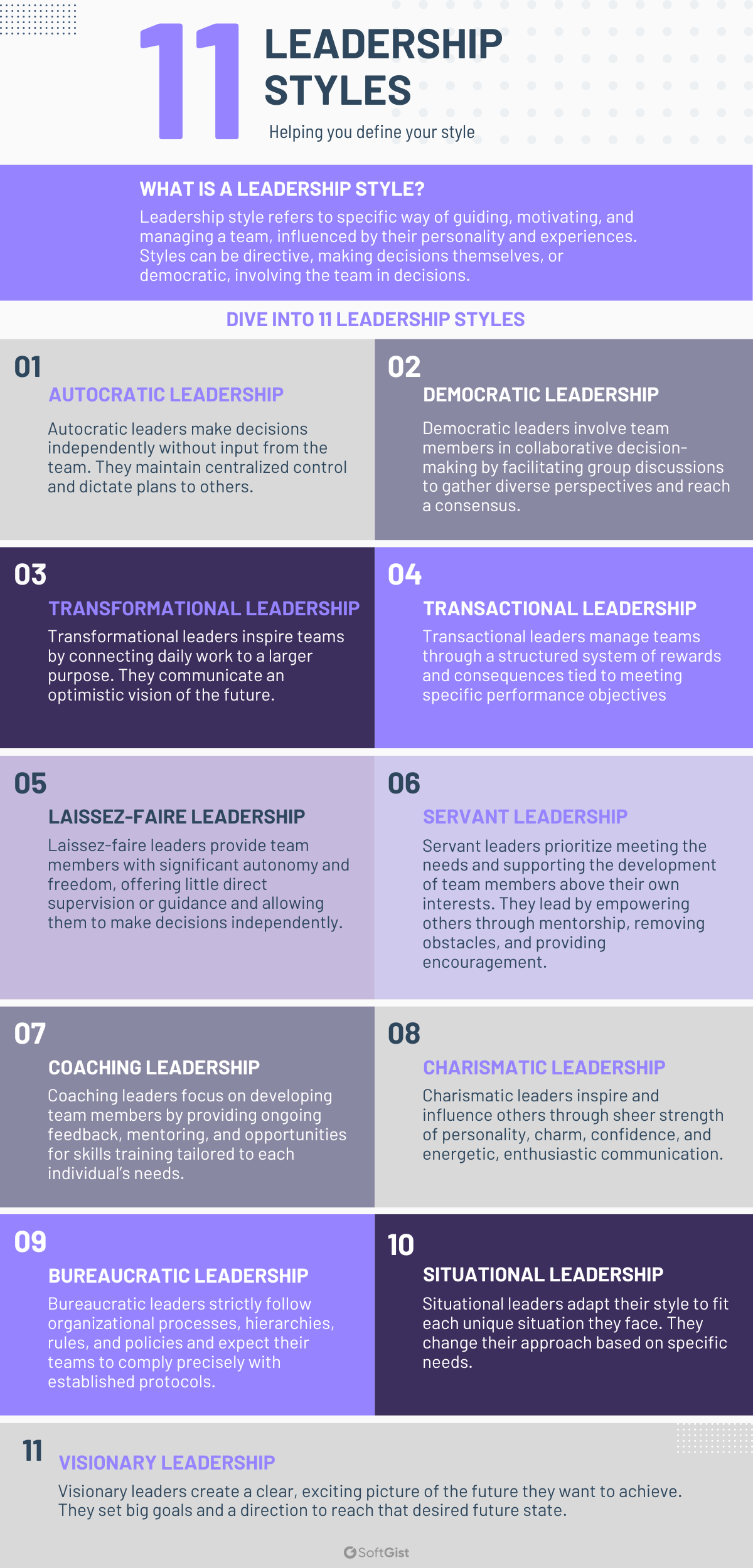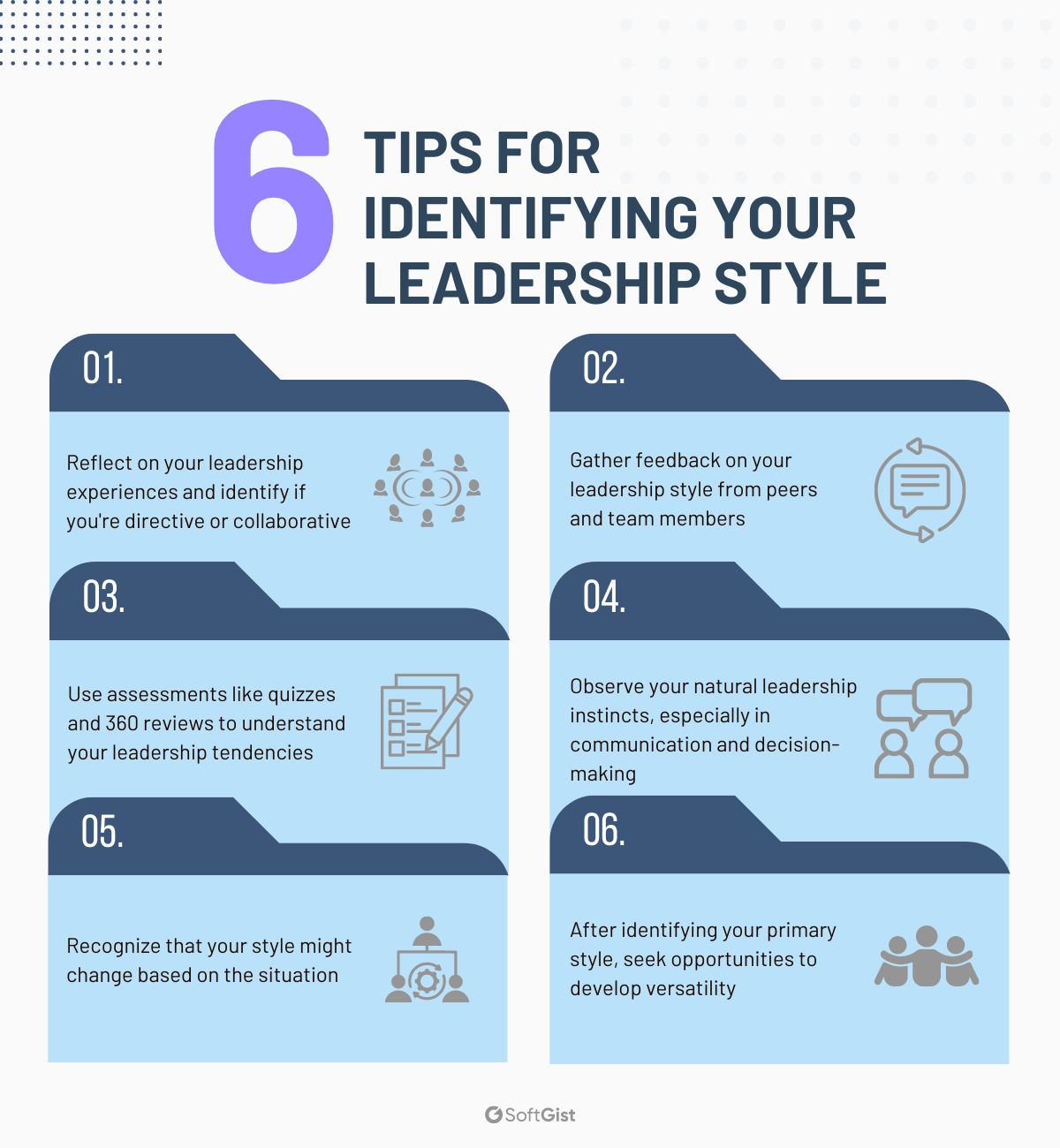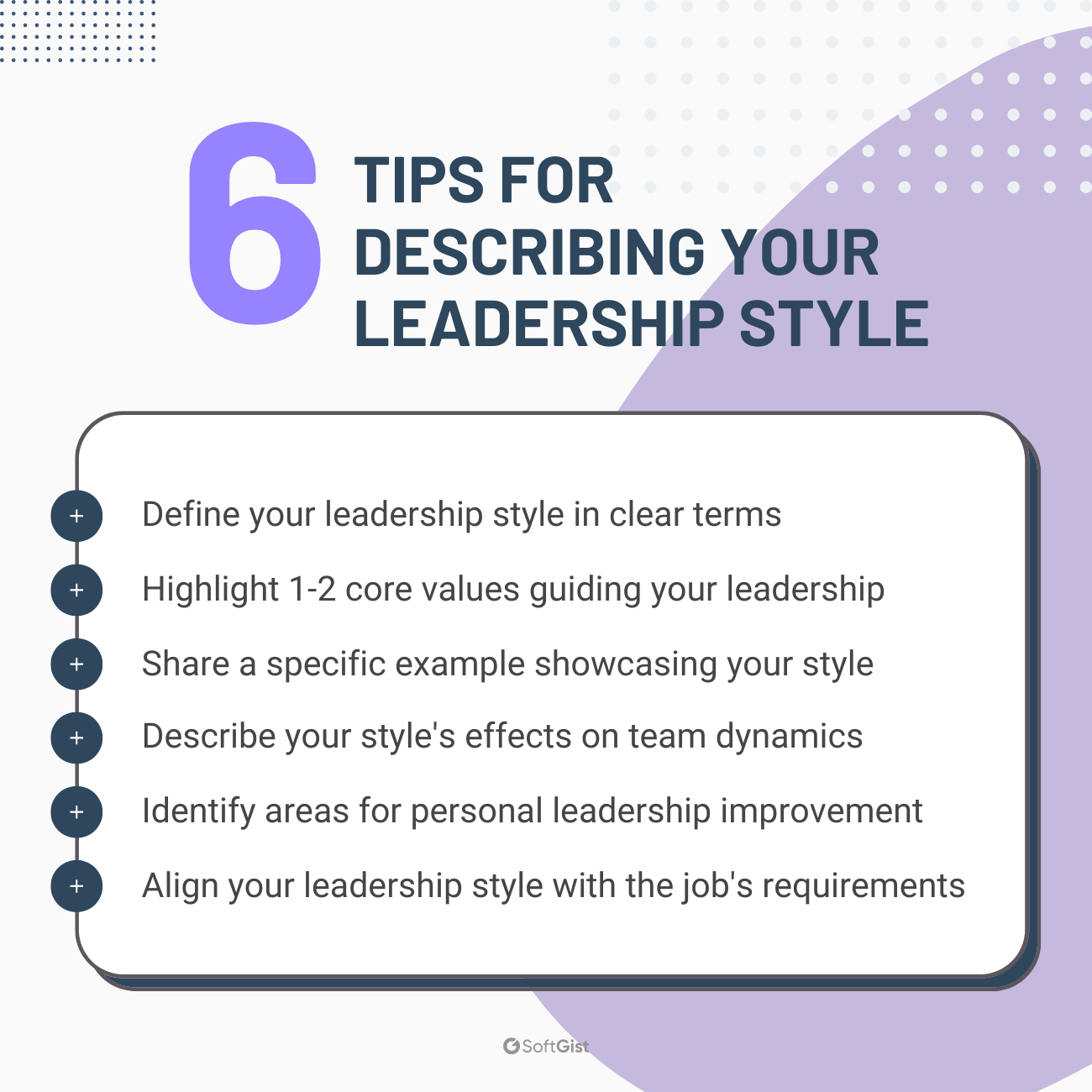How to Answer “Describe Your Leadership Style” (with Examples)
Updated May 27, 2024
Published July 20, 2023

Being asked about your leadership style in an interview can seem daunting. However, it’s a common and important question that offers a valuable opportunity to showcase your self-awareness and approach.
This article will equip you to master this question. We’ll overview common leadership styles, help you evaluate your leadership style, and show you the best way to answer this question with examples.
Let’s dive in!
What is a leadership style?
A leadership style refers to a leader’s unique approach to guiding, motivating, and managing a team. It encompasses their blend of skills, qualities, and behaviors used to interact with the team and accomplish goals.
Leadership styles vary widely based on a leader’s personality, experiences, and work context. Some leaders are more directive, preferring to make decisions and outline plans. Others are more democratic, involving their team in decision-making to foster collaboration.
Why do Employers Ask About Your Leadership Style?
When an interviewer asks you to describe your leadership style, they assess several aspects of your candidacy.
First and foremost, your answer conveys self-awareness. Being able to discuss your natural tendencies and strengths thoughtfully demonstrates emotional intelligence and maturity as a leader.
Additionally, your approach reveals how you think through decisions. For instance, are you inclined to gather team perspectives or independently call the shots? This provides a window into your judgment process.
Your style also indicates how you would manage, motivate, and communicate with employees day-to-day. It highlights your philosophy around mentoring, collaboration, and more. The employer evaluates whether your style suits the role and aligns with the company’s ingrained culture.
Finally, a versatile leader who can adapt their style to different situations is highly valued. Your ability to adjust and lead effectively across varying team dynamics is critical.
In essence, this common question allows employers to gauge your self-reflection, critical thinking, and organizational fit – all through the lens of your leadership style.
11 Common Leadership Styles
Here is an expanded version of the 11 common leadership styles section with more detail and alternative names for each style:

Autocratic leaders make decisions independently without input from the team. They maintain centralized control and dictate plans to others.
When it works best: Autocratic leadership provides extremely efficient direction when rapid response is required, such as in emergencies or crisis situations that demand quick decision-making.
Potential limitations: Autocratic leadership can damage morale, stifle creativity, and spur high turnover by not considering ideas from others on the team. Team members may feel their contribution and perspective are not valued under this style.
2. Democratic Leadership (Also known as Participative leadership)
Democratic leaders involve team members in collaborative decision-making by facilitating group discussions to gather diverse perspectives and reach a consensus.
When it works best: This style works well when buy-in and agreement from the team are important before implementing changes or starting new initiatives.
Potential limitations: While inclusive, the consensus-building process in democratic leadership can slow down decision-making. It may be ineffective in situations where rapid responses are required.
3. Transformational Leadership
Transformational leaders inspire teams by connecting daily work to a larger purpose. They communicate an optimistic vision of the future.
When it works best: Transformational leadership sparks innovation and change by energizing people around a shared vision of the future. This style helps drive new thinking and strategic directions when major changes are needed.
Potential limitations: Transformational leaders can focus too heavily on the “big picture” vision while lacking the operational skills to execute it. This leadership style needs to balance high ideals with detailed, on-the-ground planning to achieve the vision.
4. Transactional Leadership
Transactional leaders manage teams through a structured system of rewards and consequences tied to meeting specific performance objectives.
When it works best: This style provides consistency and predictability by setting clear expectations and parameters for earning incentives. Employees understand what they need to do to be rewarded.
Potential limitations: Transactional leadership can limit creativity, innovation, and responsibility to only what gets rewarded. It discourages risk-taking and thinking outside the box beyond basic requirements.
5. Laissez-Faire Leadership (Also known as Delegative leadership)
Laissez-faire leaders provide team members with significant autonomy and freedom, offering little direct supervision or guidance and allowing them to make decisions independently.
When it works best: This style works well when leading highly skilled, experienced, and self-motivated teams that require little oversight.
Potential limitations: With little direction from the leader, laissez-faire leadership can result in a lack of cohesion and accountability. It may not work as well for less experienced teams needing more guidance.
6. Servant Leadership
Servant leaders prioritize meeting the needs and supporting the development of team members above their own interests. They lead by empowering others through mentorship, removing obstacles, and providing encouragement.
When it works best: This style builds a highly engaged team culture by fostering loyalty and trust through the leader’s focus on each individual’s growth and well-being.
Potential limitations: The servant leader’s emphasis on the needs of others above their own can potentially undermine their authority. Some may take advantage of the leader’s generosity.
7. Coaching Leadership
Coaching leaders focus on developing team members by providing ongoing feedback, mentoring, and opportunities for skills training tailored to each individual’s needs.
When it works best: This style helps team members continuously improve their capabilities and performance by taking a hands-on, personalized approach to their professional growth.
Potential limitations: Coaching is time-intensive and requires leaders skilled in listening, diagnosing needs, giving constructive criticism, and training others. It may not work well with team members resistant to feedback.
8. Charismatic Leadership
Charismatic leaders inspire and influence others through sheer strength of personality, charm, confidence, and energetic, enthusiastic communication.
When it works best: This style can rally and excite teams around a vision, especially during periods of change or crisis. Charismatic leaders get buy-in through passion.
Potential limitations: If passion is their sole strength, charismatic leaders may lack substance or practical strategies behind their vision. Their success depends on combining charisma with real plans.
9. Bureaucratic Leadership
Bureaucratic leaders strictly follow organizational processes, hierarchies, rules, and policies and expect their teams to comply precisely with established protocols.
When it works best: This style brings consistency and stability to organizations in highly regulated industries like finance, healthcare, and aviation, where strict adherence to standards is critical.
Potential limitations: The bureaucratic style can limit flexibility, stifle creativity, and hinder agility. Organizations may get bogged down in excessive rules and need help to quickly adapt to changing market conditions.
10. Situational Leadership
Situational leaders adapt their style to fit each unique situation they face. They change their approach based on specific needs.
When it works best: This flexible style allows leaders to be effective in diverse settings. They can adjust based on the circumstances.
Potential limitations: It requires leaders highly skilled at reading situations. They must know when and how to change gears.
Visionary leaders create a clear, exciting picture of the future they want to achieve. They set big goals and a direction to reach that desired future state.
When it works best: This style motivates teams by sharing an ambitious vision. It sparks new ideas by keeping focus on future possibilities.
Potential limitations: The emphasis on a bold long-term vision can mean teams lack step-by-step practical plans. More guidance may be needed on how to achieve the vision.
Identify Your Leadership Style
Knowing your natural leadership style is key to playing to your strengths while recognizing areas for growth. Here are some tips to help identify your tendencies:

- Reflect on past experiences leading teams. What approaches did you lean towards – were you more directive or collaborative? How did your style impact team dynamics and outcomes? Look for patterns in your instincts and behaviors.
- Think about feedback from others. Ask mentors, colleagues, and team members for input on your style. Listen for common themes around your strengths and development areas.
- Take leadership style assessments. Structured tools like leadership style quizzes, tests, and 360 reviews can provide objective insights into your tendencies.
- Pay attention to your natural inclinations when leading. Note when you tend to take charge versus empower others. Observe how you communicate, make decisions, provide feedback, and more.
- Consider the context. Your style likely adapts to different situations. Note how you adjust your approach based on the team, challenges, and goals.
- Identify areas to develop. Once you recognize your typical style, you can work to expand your versatility as a leader. Look for opportunities to stretch beyond your comfort zone.
Determining and developing your leadership style takes ongoing self-reflection. But understanding your natural tendencies helps you lead at your best while expanding your skills.
Describing Your Leadership Style
When asked about your leadership style, follow these tips to describe it effectively:

- Start with a brief definition in 1-2 sentences. Summarize your overall approach in clear, simple terms. For example, “I have a collaborative leadership style focused on building consensus.”
- Share principles that shape your style. Explain 1-2 core values that drive your leadership, like fostering teamwork, developing people, or leading by example.
- Provide a specific example that illustrates your style. Share a story of a time you involved your team in a decision or coached someone to improve their skills.
- Discuss the impact on your team. Explain how your style influences team dynamics, motivation, and performance. For example, “My collaborative approach empowers people and helps build trust and buy-in for new initiatives.”
- Recognize your growth areas. If relevant, identify aspects of leadership you’re working on developing, like being more decisive or communicative.
- Tailor your description to the role. Align your description with the company’s needs and leadership expectations for the position.
With concise examples and measurable impacts, you can showcase self-awareness and persuade the interviewer your leadership style aligns with the role.
10 Example Answers
Transformational Leadership Style
My leadership style is transformational. I believe in inspiring and motivating my team to achieve our shared goals through clear vision and empowerment. For example, when I led a 10-person sales team, I set specific targets tailored to each rep’s strengths and empowered them to take ownership of improving their sales processes. This transformational approach increased overall team performance by 20% within 6 months and created a positive and supportive work environment.
Situational Leadership Approach
I have a situational leadership style and adapt my approach based on my team’s needs. When I led a 15-person customer service team that was facing a high volume of customer complaints, I assessed that the team needed more direct guidance. So I became more hands-on, working closely with team members to resolve customer issues, improve response time by 50%, and implement new service processes. This situational approach helped improve customer satisfaction scores by 15% and maintain our reputation as a reliable and customer-focused company.
Servant Leadership Style
My leadership style reflects a servant philosophy where I prioritize the needs of my team members and empower them to do their best work. For example, when I led a 5-person project team, one team member was struggling with a personal family issue. I made sure to meet with them privately, provide the emotional support they needed, and offer flexibility in their schedule while ensuring they felt comfortable bringing their whole self to work. This level of care fostered a strong and highly motivated team that came together to deliver the project 2 weeks ahead of schedule with outstanding results.
Democratic Leadership Approach
My leadership style is highly democratic. I believe in building consensus and making decisions collaboratively. For example, when I led a 7-person product development team that was facing a difficult design decision on a new prototype, I brought the full team together to openly discuss the pros and cons of the different design options. As a group, we weighed the options and made the final decision based on the collective input and ideas of each team member. By giving each person a voice, I was able to build trusted relationships. This collaborative approach led to informed, effective decisions and a successful product launch that exceeded our sales goals for the quarter.
Laissez-Faire Leadership Style
I embrace a laissez-faire leadership style where I give my team members the freedom and autonomy to do their jobs in the way they feel is most effective. For example, when I led a small creative team of 4 graphic designers and copywriters, I intentionally gave them flexibility in how they approached projects. I let them explore innovative ideas and trusted their expertise while providing high-level guidance as needed. This laissez-faire approach resulted in fresh, creative output for clients and improved my team’s morale, motivation, and pride in their work.
Visionary Leadership Approach
My leadership style is inherently visionary. I am skilled at looking to the future, crafting a compelling vision for where we can go, and charting a strategic course to get there. For example, when I co-founded and led an early-stage tech startup, I was able to clearly articulate our 5-year vision to disrupt the industry. This vision of the future inspired my 12-person team to work tirelessly through the growing pains to bring our shared vision to life. By focusing on the bigger picture, I drove success for this startup through an ambitious vision that provided purpose and direction even in challenging times.
Charismatic Leadership Style
I have an enthusiastic, charismatic leadership style where I use my energy and passion to inspire and motivate my team. For example, when I led a 10-person sales team that had been underperforming, I gave motivational speeches in our weekly team meetings focused on recognizing progress and outlining the exciting vision for growth. I also held regular one-on-one coaching sessions where I worked individually with reps to understand their challenges and helped them create customized strategies and action plans to boost their personal sales figures. This charismatic approach focused on passion and positivity helped improve sales team performance by 30% over that quarter and boosted morale by re-energizing the team around our shared mission and goals.
Transactional Leadership Approach
My leadership approach follows a transactional style where I establish clear structures, processes, goals, and incentives to drive results. For example, when I was brought in to lead a struggling manufacturing team of 18 people, I implemented standardized production quotas, quality control protocols, and operational processes to improve team efficiency. I provided rewards to top performers who exceeded expectations. Within the first two months, this transactional focus on setting clear expectations along with performance-based incentives led to a 20% increase in units produced per hour, 10% higher product quality, and improved accountability across all shifts. By taking a systematic approach, I could drive rapid operational improvements.
Collaborative Leadership Style
I have a highly collaborative leadership style where I work closely with my team to achieve shared goals and make decisions together. For example, when I was hired to lead a cross-functional project team of 10 people from IT, sales, marketing, and product, I brought together these diverse perspectives through regular brainstorming sessions. When making critical project decisions, I facilitated open discussion and built consensus before finalizing our plans. This collaborative approach fostered a strong sense of teamwork even between departments that rarely interacted. In the end, the project delivered a 35% increase in customer conversions by effectively incorporating insights from all team members in our solution.
Coaching Leadership Approach
My leadership approach is centered on coaching and developing my team members. When I was managing a customer service team of 15 reps, I scheduled bi-weekly one-on-one meetings with each person focused on their career goals and customized training plans. I provided ongoing feedback and hands-on guidance to help them improve skills in areas like de-escalating difficult calls. This regular coaching led to a 25% increase in first-call resolution rates within 3 months. By taking a genuine interest in their growth, I drove higher performance while also increasing job satisfaction, morale, and talent retention on the team.
Direct Leadership Style
I lead with a very direct, action-oriented style. When I was managing a software development team of 8 engineers working on a complex project with a tight deadline, I provided extremely clear guidance and specific instructions to keep the team focused. For example, I outlined detailed project plans with precise timelines, budgets, and milestones. In our stand-up meetings, I gave concise directions and delegated tasks based on each person’s strengths. This direct approach ensured maximum productivity and efficiency from the team. We ended up launching ahead of schedule and 15% under budget by maintaining tight execution through my hands-on leadership style.
Progressive Leadership Approach
My leadership style aims to foster innovation, embrace change, and encourage experimentation. As a marketing leader managing a talented team of 10, I gave them the flexibility to challenge established practices and try new strategies. When we needed to increase social media engagement, I empowered my team to brainstorm fresh ideas and test unconventional approaches without judgment. With my support, they created a viral social campaign that increased our follower count by 20%. I drove results by consistently pushing my team to think outside the box and take smart risks rather than sticking to the status quo.
Strategic Leadership Style
I lead with a strategic, future-oriented approach. As a director of operations overseeing a 50-person customer service department, I focused on understanding emerging trends, identifying risks and opportunities, and positioning ourselves for long-term success. When customer behaviors were changing, I directed my team to research the drivers and develop proactive strategies to get ahead of the curve. My long-range planning allowed us to roll out targeted service packages before competitors, leading to a 12% increase in retained revenue year-over-year.
Inclusive Leadership Style
My leadership style emphasizes inclusivity, open dialogue, and amplifying diverse voices. As an engineering manager, I made sure to actively listen to all team members and consider all perspectives when making decisions. When tensions arose about project timelines, I brought everyone together to express their concerns and collaboratively develop solutions. My aim was to create a trusting, respectful culture where the team felt heard. Over 2 years, this inclusive approach led to a 20% increase in team diversity and much higher morale and retention ratings in employee surveys.
Final Thoughts
Describing your leadership style concisely shows self-awareness and management capability. The best leaders can articulate their approach using clear examples of their style in action and positive impacts. Though your natural tendencies matter, situational adaptability is also key. With preparation, you can emphasize your strengths as a leader during interviews and in your career. Great leaders develop a flexible style to motivate diverse teams.
Share This Post
Ada Rivers
Ada Rivers is a senior writer and marketer with a Master’s in Global Marketing. She enjoys helping businesses reach their audience. In her free time, she likes hiking, cooking, and practicing yoga.
Allow cookies
This website uses cookies to enhance the user experience and for essential analytics purposes. By continuing to use the site, you agree to our use of cookies.
